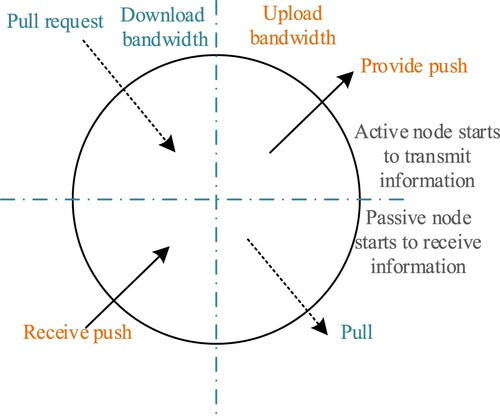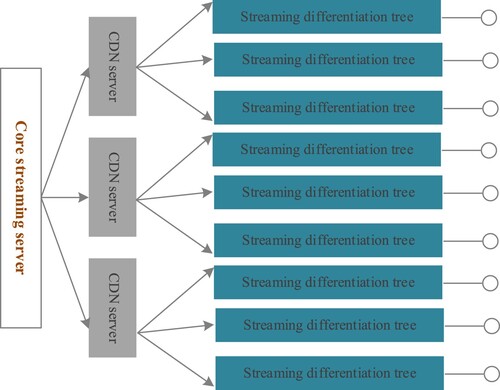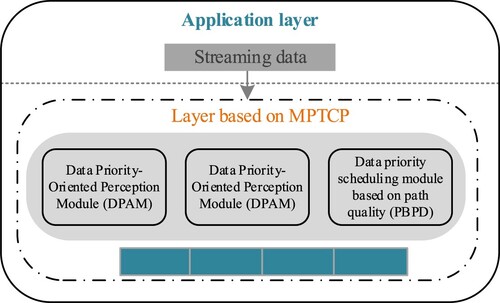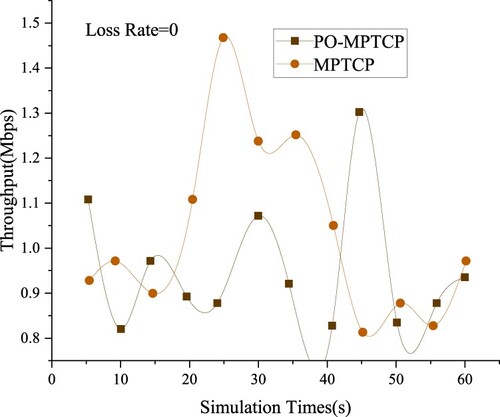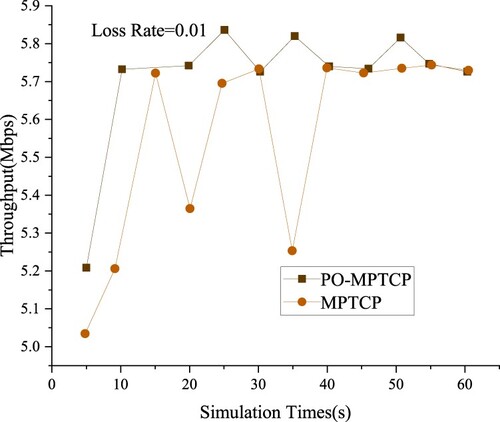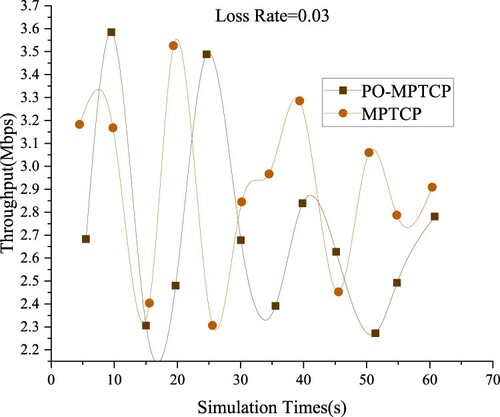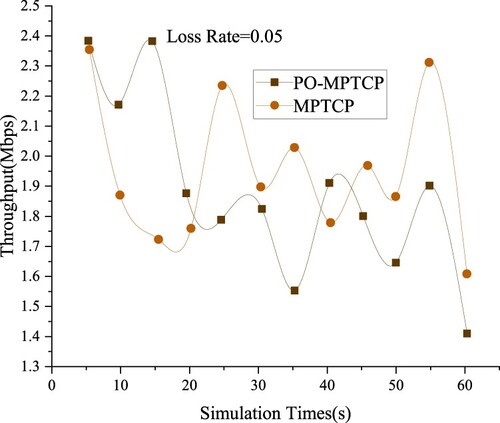 ?Mathematical formulae have been encoded as MathML and are displayed in this HTML version using MathJax in order to improve their display. Uncheck the box to turn MathJax off. This feature requires Javascript. Click on a formula to zoom.
?Mathematical formulae have been encoded as MathML and are displayed in this HTML version using MathJax in order to improve their display. Uncheck the box to turn MathJax off. This feature requires Javascript. Click on a formula to zoom.Abstract
With the rapid growth of streaming media services, users have higher and higher requirements for streaming media transmission rates and network experience. Experiments show that in multi-path streaming media transmission services, supporting streaming services with high bandwidth and low latency is a very challenging task. Based on this, this article explores and establishes a digital streaming media distribution and transmission process optimisation model based on an adaptive recurrent neural network. This paper proposes a priority-aware streaming media multi-path data scheduling mechanism, which allows applications to distinguish the relative importance of data and ensure that high-priority data is transmitted on the path with the best quality. The adaptive recurrent neural network algorithm is used in the optimisation process of the distribution and transmission process. By simulating the real environment, it is verified that the model can improve the efficiency of distribution resources and reduce the access rejection rate and data jitter caused by interruption.
1. Introduction
Mobile Internet streaming media technology has changed all aspects of people's lives and expanded the way people obtain information and entertainment. The business flexibility of mobile Internet streaming media applications that are not restricted by time and location, and the richness of content have become favourable conditions for the development of mobile Internet streaming media technology (Fekri et al., Citation2021; Lee et al., Citation2019). Streaming media content is digital information, which makes it very convenient to distribute and copy streaming media content. In addition, mobile terminals can easily access rich streaming media content at any place and at any time (Bartal & Ravid, Citation2021; Goldfarb & David, Citation2015). Therefore, how to improve the speed of the digital streaming media distribution and transmission process is becoming increasingly important under the mobile Internet.
At present, the academic community has carried out research and discussion on the dynamically changing network background flow in the process of multi-path streaming media data transmission and the priority-oriented data scheduling optimisation scheme (Goncalves et al., Citation2016; Jia et al., Citation2015). Authors such as Kimura, B discussed three data scheduling mechanisms based on the multi-path transmission control protocol, that is, the data scheduling mechanism based on the highest developed rate, to analyze the transmission performance of the protocol on different scheduling mechanisms (Kimura et al., Citation2017). Authors such as Diop, C extended the multi-path transmission control protocol and proposed a quality-oriented multimedia multi-navigation system (Diop et al., Citation2012). By implementing the concept of “partial reliability” in the transport protocol to the effect of interactive video applications, two different mechanisms can be used to improve the quality of video transmission. Kim, J et al. proposed a strategy for managing the multipath transmission control protocol based on the size of the receiving buffer area. He used the dissimilar characteristics of the multipath based on the available receiving buffer area to operate (Kim et al., Citation2017). On the other hand, frame-based data transmission often adopts the CRC check method for error detection. When an error occurs, the entire data is requested to be retransmitted. In order to avoid retransmission of the entire data frame due to individual errors, Shukla, S, etc. have proposed suitable for high-speed data transmission. An FPGA-based implementation of CRC-16 that can correct a single bit error (Shukla & Bergmann, Citation2004). Based on this, Babaie, S et al. proposed a CRC error correction scheme that can correct double-bit errors (Babaie et al., Citation2009).
With the large-scale application of diversified wireless network access technologies and multi-network interface equipment, how to organically integrate multiple wireless access technologies, give play to the network transmission performance of multi-homed terminals and rationally use heterogeneous network resources, so as to effectively research on improving the transmission service quality of streaming media data has received extensive attention from academic circles at home and abroad (Liikkanen & Aman, Citation2016; Quinlan et al., Citation2015). Based on this, this article explores and establishes a digital streaming media distribution and transmission process optimisation model based on an adaptive recurrent neural network. Based on the transmission performance of multi-path streaming media, we expound the research background, research status and main research contents of this paper. also. By studying the streaming media distribution and transmission protection technology under the mobile Internet, certain theoretical significance and commercial value can be achieved.
2. Streaming media transmission mechanism
Traditional video coding methods are limited to transmission in a complex network environment. The fundamental reason is that they compress the video into one or several fixed bit rate video streams (Cai et al., Citation2021; Zhang et al., Citation2021). Due to the heterogeneity of the network and the lack of service quality assurance, the actual end-to-end bandwidth is affected by many factors and will continue to change within a large range. In the push process, each node will provide a set of slice sets to its neighbour nodes, but in fact it will only push information to the neighbour node that confirms the reception first (Chen et al., Citation2021; Tan, Citation2020). After receiving the first confirmation message, all other neighbour nodes will be clear. Rejection (Ramamurthy & Luthra, Citation2017). In the pull process, the node sends the slice set request it needs to its neighbour nodes, and also only establishes a connection with the first neighbour node that proactively replies (Xiang et al., Citation2021; Yan et al., Citation2021). After the connection is established, other neighbour nodes are also explicitly rejected. Figure describes the pull or push status changes of streaming media node information.
Therefore, video coding for network transmission needs to compress the video into a video stream that can adapt to a certain range of bitrates (Bai et al., Citation2021; Ning et al., Citation2020). In addition, due to differences in the situation of each client, such as differences in display resolution and video image usage, different users have different requirements for the quality of decoded and reconstructed video images (Yang et al., Citation2020). The description of the protocol is completed by the behaviour of passive nodes. When a node is queried by other nodes, each node may receive many push requests, and then only receive its own missing slices and reject other slices (Dang et al., Citation2020; Zhao et al., Citation2020). Parallel multi-path transmission protocol inherits the multi-homing feature realised by SCTP, that is, during data transmission, it can not only establish a connection with the characteristics of SCTP, but also can send data blocks concurrently through multiple independent end-to-end paths (Baldesi et al., Citation2017). Therefore, wireless terminal devices equipped with multiple network interfaces use protocols to achieve parallel transmission and bandwidth aggregation in a practical sense, which can effectively improve data transmission efficiency, network resource utilisation, and network transmission stability (Chen et al., Citation2020; Dong et al., Citation2019). Figure depicts a schematic diagram of the multi-path transmission control protocol plank road.
Similarly, among the many pull requests received, each node only satisfies one of them (Lu, Citation2021; You et al., Citation2021). Obviously, a node can choose its own activation state, it can decide that it is in the push or pull state, but it cannot control the type of query it receives, so alternate push/pull selection during query is impossible.
3. Real-time distribution of streaming media
3.1. Multi-level distribution index
The boundary limitation problem of the distribution network consists of three parts: time, quality, and mobile node bandwidth and processing capacity (Liu et al., Citation2020; Qi et al., Citation2021). It is assumed that all mobile nodes have effective links with CDN servers or real-time streaming media distribution networks with CDN services as the core. The mobile node always maintains a connection relationship with the distribution network, and based on this, a multi-objective programming model is established. This is a network with base stations as an example (Song et al., Citation2021). Because streaming media distribution uses P2P on the transmission path, in one direction, nodes far away from the centre can directly access nodes near the centre with the same service requirements than directly accessing the service centre nodes through other nodes, which saves the bandwidth of the central service node and the backbone network. flow. Figure shows a schematic diagram of the multi-level distribution index structure.
The user's application of the data service starts from accessing the CDN server. Some basic information of users is also stored in the CDN server. In the model, the CDN server has functions such as content management, user authorisation, authentication, indexing, and redirection. Only when the CDN server's own bandwidth and processing capacity cannot establish a real-time distribution tree at this level, the user's access application is submitted to the core streaming media server.
3.2. Distribution optimisation based on recurrent neural network
RNN uses the idea of parameter sharing, introducing a state variable to the impact of the input at the time before storage, and it is assumed that the state variable at a certain time can be represented by the state variable at the previous time and the input at that time, so that the sequence data can be represented at a single time deal with.
(1)
(1) This not only can handle variable-length sequence data, but also reduces the complexity of the model and reduces the possibility of overfitting. Figure shows a schematic diagram of the structure of a common recurrent neural network model.
It can be found that the RNN uses the state vector to record its own response at this moment and other methods of its own degree of response, instead of the ARMAX model except for the input, output and noise at the next moment.
(2)
(2)
(3)
(3) In this way, the response update method involving multiple moments in the ARMAX model is transformed into a state function update method involving only a single moment.
(4)
(4) However, the state variable needs to store information in a long time range and extract valid information, that is, the data range that can affect a certain specific data in the selected sequence, so that this part of the data is convolved and output.
(5)
(5)
(6)
(6) The difficulty of adding gradient transfer makes model training more difficult. A model uses a damage function to measure the difference between the model's predicted value and the true value of streaming media noise.
(7)
(7) The training process of a neural network is actually a process of minimising the loss function. We need to choose the loss function according to the actual problem to avoid bias due to different loss functions.
4. Multi-path streaming media scheduling
4.1. Priority-based scheduling mechanism
In view of the fact that researchers ignore the impact of the dynamically changing network environment on data transmission performance, they rarely consider the priority requirements of data transmission, which leads to problems such as user network experience. This paper proposes a priority-aware streaming media multi-path data scheduling mechanism (PO-MPTCP), which allows applications to distinguish the relative importance of data, ensuring that high-priority data is transmitted on the best quality path, and improving. The overall transmission performance of streaming media services is improved. How to organically integrate multiple wireless access technologies, give full play to the network transmission performance of multi-homed terminals, and make rational use of heterogeneous network resources is the first problem to be faced. With the large-scale application of diversified wireless network access technologies and multi-network interface devices, rational optimisation of network resources is also a top priority.
The system architecture of the priority-oriented MPTCP data scheduling strategy is shown in Figure . We have designed three modules at the sending end: a data priority-oriented perception module, a multi-attribute-aware path switching module, and a path quality-based data priority scheduling module to implement data priority scheduling.
When there is data to be sent at the application layer, the sender of PO-MPTCP buffers the data transferred from the application layer to the transport layer through a multi-stream buffer module similar to SCTP, and then senses and records the priority of the data to be transferred through the data priority perception module information. The path quality-based data priority scheduling policy schedules data packets according to the data priority size and the sorted path, and then transmits them down to the network layer and transmits them to the receiver through the network. Then the multi-attribute-aware path switching module judges the status of each sub-path according to the RTT and CWND values of each path, and arranges the paths from high to low according to the quality of the paths. The PO-MPTCP receiving end reorganises the data in sequence after receiving the data packet and passes it to the upper layer of the receiving end.
4.2. Simulation of scheduling effects
The use of multi-path transmission of video streams is to maximise the use of bandwidth to improve the quality of the video. How to avoid packet loss due to congestion is the core problem that needs to be solved in multi-path transmission. In order to test the above technologies more conveniently, and considering the limitations of actual test conditions, this test uses three computers for simulation, one as a server, one as a client, and the other as a bandwidth controller. The load sharing model comprehensively considers the available bandwidth and packet loss rate on each path to determine and adjust the data transmission rate to meet the actual bandwidth demand and to equalise the end-to-end delay. The bandwidth aggregation technology of multipath transmission adopts a load sharing model, and the client uses a smaller buffer to sort out of sequence packets. The gateways of the client and server are respectively set to the IP addresses of the two network cards of the bandwidth controller, and the bandwidth controller uses TrafficControl to limit the bandwidth passing through it. At the same time, it is pointed out that there is no more mature solution for adaptive streaming media transmission based on bandwidth convergence technology.
Average throughput is one of the most important parameters to measure network performance. In the analysis of simulation results, researchers usually use throughput to judge the overall performance of the algorithm. Figures and shows the throughput changes of MPTCP and PO-MPTCP in the simulation experiment when the packet loss rate is 0 and 0.01.
From the figure, we can see that PO-MPTCP achieves higher transmission throughput. The former showed a rapid increase in server data traffic at the beginning of the test, but over time, the trend became flat. The latter shows a gradual leap-type growth feature, the longer the time, the more frequent the jump, and the tail trend rises. By analyzing the process of system modelling and distribution system construction, it can be seen that the reason for this sharp contrast is that the server function in the hybrid model has undergone three phases and two transitions. Figures and shows the throughput changes of MPTCP and PO-MPTCP in the simulation experiment when the packet loss rate is 0 and 0.01.
It can be seen from the figure that the faster the node moves, the more frequent the switching within the same time, which is the same as the expected conclusion. The purpose of quality adaptive scheduling is to achieve the highest video quality that allows for uninterrupted playback. When selecting video quality, the client first calculates how much data it has received and how much data it has cached. Among them, in the case of walking, the switching point was not captured in the experiment due to the limited range of motion. It can be seen that the effect of the mobile switching algorithm is not obvious when the speed is very low. Then, the time required to receive the requested data is estimated. For each level of video quality, the client separately calculates how long it takes to receive sub-segments. By subtracting the pipeline delay from the transmission cutoff time, it is possible to estimate how much extra time is needed to receive the data without loss. If the transmission time is less than the estimate, the video sub-segment should be transmitted and ready to be played before the loss occurs, and finally the quality level selected by the client is returned to the scheduler.
5. Conclusion
This article focuses on the research and discussion of streaming media distribution technology and bandwidth convergence technology. In the technical overview, the related technology and its own research results are introduced in more detail. At the same time, it is pointed out that there is no more mature solution for adaptive streaming media transmission based on bandwidth convergence technology. This paper uses the distribution characteristics of time delay to reasonably predict the handover timing of mobile nodes, solves the problem of seamless handover in real-time streaming media distribution in mobile networks, and improves the distribution quality. This paper will put forward an implementation scheme of a streaming media transmission system based on priority and cyclic neural network optimisation on the existing basis, which provides a solid quantitative basis for the application and management of wireless networks in the future. However, due to the complexity of wireless network issues, although this article has carried out a useful analysis and optimisation of MPTCP streaming media transmission performance, it is still limited. In heterogeneous wireless multi-path transmission scenarios, when users request streaming media application data in a highly dynamic wireless network, they are often affected by environmental factors such as geographic location. This is worthy of our further analysis.
Disclosure statement
No potential conflict of interest was reported by the author(s).
References
- Babaie, S., Zadeh, A. K., Es-Hagi, S. H., & Navimipour, N. J. (2009). Double bits error correction using CRC method. (Ed.), ∧(Eds.). International Conference on Semantics.
- Bai, X., Wang, X., Liu, X., Liu, Q., & Kim, B. (2021). Explainable deep learning for efficient and robust pattern recognition: A survey of recent developments. Pattern Recognition, 120. https://doi.org/10.1016/j.patcog.2021.108102
- Baldesi, L., Maccari, L., & Cigno, R. L. (2017). On the use of eigenvector centrality for cooperative streaming. IEEE Communications Letters, 21(9), 1953–1956. https://doi.org/10.1109/LCOMM.2017.2713361
- Bartal, A., & Ravid, G. (2021). Analyzing a large and unobtainable relationship graph using a streaming activity graph. Information Sciences, 546(1), 1097–1112. https://doi.org/10.1016/j.ins.2020.09.063
- Cai, W., Liu, D., & Ning, X. (2021). Voxel-based three-view hybrid Parallel network for 3D object classification. Displays, 69(1), 322–334. https://doi.org/10.1016/j.displa.2021.102076
- Chen, Z., Huang, J., & Ahn, H. (2020). Item response theory based ensemble in machine learning. International Journal of Automation and Computing, 17(05), 621–636. https://doi.org/10.1007/s11633-020-1239-y
- Chen, Z., Huang, J., & Ahn, H. (2021). Costly features classification using Monte Carlo Tree Search. arXiv preprint, arXiv,2102.07073.
- Dang, X., Shi, Y., & Peng, H. (2020). Torque-flux linkage recurrent neural network adaptive inversion control of torque for switched reluctance motor. IET Electric Power Applications, 14(9), 1612–1623. https://doi.org/10.1049/iet-epa.2020.0105
- Diop, C., Dugue, G., & Gomez, J. (2012). QoS-aware and autonomic-oriented multi-path TCP extensions for mobile and multimedia applications. International Journal of Pervasive Computing and Communications, 8(4), 306–328. https://doi.org/10.1108/17427371211283001
- Dong, W., Hong, W., Dai, Y. D., Wang, P., & Xuan, H. F. (2019). Road traffic state prediction based on a graph embedding recurrent neural network under the SCATS. Chaos: An Interdisciplinary Journal of Nonlinear Science, 29(10), 103125–103125. https://doi.org/10.1063/1.5117180
- Fekri, M. N., Patel, H., Grolinger, K., & Sharma, V. (2021). Deep learning for load forecasting with smart meter data: Online adaptive recurrent neural network. Applied Energy, 282. https://doi.org/10.1016/j.apenergy.2020.116177
- Goldfarb, David, A (2015). Re: Renal transplantation using belatacept without maintenance steroids or calcineurin inhibitors. Journal of Urology, 193(3), 950–950. https://doi.org/10.1016/j.juro.2014.11.026
- Goncalves, G. D., Cunha, I., Vieira, A. B., & Almeida, J. M. (2016). Predicting the level of cooperation in a peer-to-peer live streaming application. Multimedia Systems, 22(2), 161–180. https://doi.org/10.1007/s00530-014-0434-5
- Jia, Y., Zhang, J., Fan, J., Chao, L., & Xiao, X. (2015). Gemstone spectral imaging reduced artefacts from metal coils or clips after treatment of cerebral aneurysms: A retrospective study of 35 patients. The British Journal of Radiology, 88(1055). https://doi.org/10.1259/bjr.20150222
- Kim, J., Oh, B. H., & Lee, J. (2017). Receive buffer based path management for MPTCP in heterogeneous networks. (Ed.), ∧(Eds.). Integrated Network & Service Management.
- Kimura, B., Lima, D., & Loureiro, A. (2017). Alternative scheduling decisions for multiPath TCP. IEEE Communications Letters, 21(11), 1–1. https://doi.org/10.1109/LCOMM.2017.2740918
- Lee, M. C., Ji, M., Molisch, A. F., & Sastry, N. (2019). Throughput-outage analysis and evaluation of cache-aided D2D networks with measured popularity distributions. IEEE Transactions on Wireless Communications, 18(11), 5316–5332. https://doi.org/10.1109/TWC.2019.2935452
- Liikkanen, L. A., & Aman, P. (2016). Shuffling services: Current trends in interacting with digital music. Interacting with Computers, 28(3), 352–371. https://doi.org/10.1093/iwc/iwv004
- Liu, Z., Han, F., & Ling, Q. H. (2020). A novel particle swarm optimization with mutation breeding. Connection Science, 32(4), 333–361. https://doi.org/10.1080/09540091.2019.1700911
- Lu, T. C. (2021). CNN Convolutional layer optimization based on quantum evolutionary algorithm. Connection Science, 33(3), 482–494. https://doi.org/10.1080/09540091.2020.1841111
- Ning, X., Duan, P., & Zhang, S. (2020). Real-Time 3D face alignment using an encoder-decoder network with an Efficient deconvolution layer. IEEE Signal Processing Letters, 27, 1944–1948. https://doi.org/10.1109/LSP.2020.3032277
- Qi, S., Ning, X., & Yang, G. (2021). Review of multi-view 3D object recognition methods based on Deep learning. Displays, 69(1), 130–142. https://doi.org/10.1016/j.displa.2021.102053
- Quinlan, J. J., Zahran, A. H., & Sreenan, C. J. (2015). ALD: Adaptive layer distribution for scalable video. Multimedia Systems, 21(5), 465–484. https://doi.org/10.1007/s00530-014-0421-x
- Ramamurthy, A., & Luthra, A. K. (2017). Method and apparatus for streaming media content to client devices. Cancer, 80(5), 2251–2256. https://doi.org/10.5594/JMI.2019.2917597
- Shukla, S., & Bergmann, N. W. (2004). Single bit error correction implementation in CRC-16 on FPGA. (Ed.), ∧(Eds.). IEEE International Conference on Field-programmable Technology.
- Song, Z., Zhao, Y., Q, X., Hui, Y., Jiang, Y., & M, H. (2021). Progressive back-projection network for COVID-CT super-resolution. Computer Methods and Programs in Biomedicine, 208. https://doi.org/10.1016/j.cmpb.2021.106193
- Tan, C. (2020). Digital confucius? Exploring the implications of artificial intelligence in spiritual education. Connection Science, 32(3), 280–291. https://doi.org/10.1080/09540091.2019.1709045
- Xiang, W. A., Chen, W. A., Bing, L. B., Xz, A., Liang, Z. A., Jin, Z. C., & Xiao, B. A. (2021). Multi-view stereo in the deep learning era: A comprehensive review. Displays, 70, 102–113. https://doi.org/10.1016/j.displa.2021.102102
- Yan, C., Pang, G., Bai, X., Liu, C., & Zhou, J. (2021). Beyond triplet loss: Person re-identification with fine-grained difference-aware pairwise loss. IEEE Transactions on Multimedia, 99, 1–1. https://doi.org/10.1109/TMM.2021.3069562
- Yang, J., Wang, X., Wang, R., & Wang, H. (2020). Combination of convolutional neural networks and recurrent neural networks for predicting soil properties using Vis–NIR spectroscopy. Geoderma, 380. https://doi.org/10.1016/j.geoderma.2020.114616
- You, H., Yu, L., Tian, S., Ma, X., & Cai, W. (2021). MC-Net: Multiple max-pooling integration module and cross multi-scale deconvolution network. Knowledge-Based Systems, 231. https://doi.org/10.1016/j.knosys.2021.107456
- Zhang, L., Li, W., Yu, L., Sun, L., & Ning, X. (2021). Gmface: An explicit function for face image representation. Displays, 68(1), https://doi.org/10.1016/j.displa.2021.102022
- Zhao, D., Wang, Z., Chen, Y., & Wei, G. (2020). Proportional-integral observer design for multidelayed sensor-saturated recurrent neural networks: A dynamic event-triggered protocol. IEEE Transactions on Cybernetics, 50(11), 4619–4632. https://doi.org/10.1109/TCYB.2020.2969377

